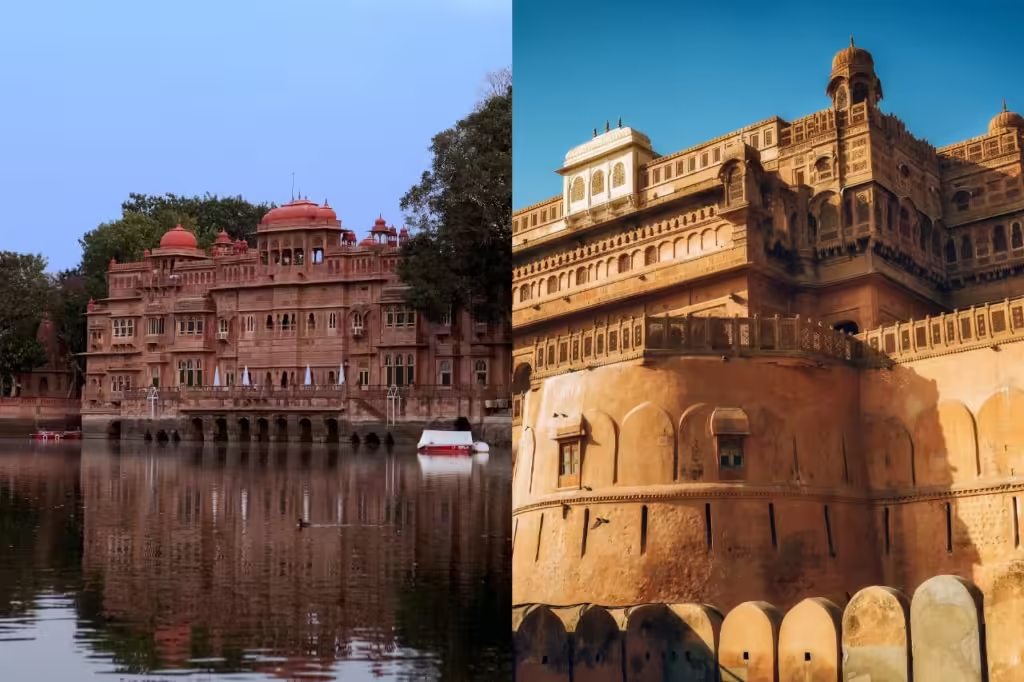Jorbeer Conservation Reserve, Bikaner: A Haven for Vultures and Wildlife
Nestled in the arid landscape of Rajasthan, Jorbeer Conservation Reserve near Bikaner stands as a unique and vital sanctuary for a diverse array of avian species, particularly vultures. This conservation reserve has gained recognition not only for its role in preserving these crucial scavengers but also for its distinctive ecosystem that attracts wildlife enthusiasts, ornithologists, and photographers from all over the world. This article delves into the significance of Jorbeer Conservation Reserve, its ecological importance, and the unique experiences it offers to those who visit.
The Ecological Importance of Jorbeer Conservation Reserve
Jorbeer Conservation Reserve is a remarkable example of how human intervention, when well-managed, can coexist harmoniously with wildlife conservation. Originally, Jorbeer was an animal carcass dumping ground, where deceased animals from nearby villages were disposed of. Over time, this site evolved into an unexpected haven for vultures and other scavenging birds, turning a seemingly mundane location into a critical conservation area.
Vultures, often referred to as nature’s cleanup crew, play an indispensable role in the ecosystem. By consuming animal carcasses, they help prevent the spread of diseases that could otherwise threaten both wildlife and human populations. However, vulture populations across India have been in sharp decline due to factors such as the widespread use of the veterinary drug diclofenac, which is lethal to vultures when they consume the flesh of treated livestock.
Jorbeer has emerged as a vital stronghold for several vulture species, including the critically endangered Oriental White-backed Vulture, Long-billed Vulture, and Egyptian Vulture. The reserve’s vast open spaces and consistent food supply make it an ideal habitat for these scavengers, allowing them to thrive and maintain a healthy population. Additionally, the presence of these birds attracts a wide variety of other species, creating a rich and diverse ecosystem.
A Birdwatcher’s Paradise
For birdwatchers and ornithologists, Jorbeer Conservation Reserve is nothing short of paradise. The reserve’s avian population is not limited to vultures; it also includes a plethora of other bird species, making it an excellent destination for anyone interested in observing and studying birds in their natural habitat.
During the winter months, the reserve becomes particularly vibrant as migratory birds from colder regions flock to the area. Species such as the Steppe Eagle, Imperial Eagle, and Griffon Vulture can be spotted soaring through the skies, adding to the already impressive list of resident birds. The sheer variety of birdlife, coupled with the unique landscape, provides ample opportunities for photography, drawing wildlife photographers from far and wide.
The Role of Jorbeer in Conservation Efforts
The conservation efforts at Jorbeer go beyond simply providing a safe space for vultures and other birds. The reserve serves as a crucial site for research and monitoring, enabling scientists to study vulture behavior, breeding patterns, and population dynamics. This research is vital for developing effective conservation strategies that can be implemented across India to protect these endangered species.
Moreover, Jorbeer plays an essential role in raising awareness about the plight of vultures and the importance of their conservation. Visitors to the reserve often leave with a deeper understanding of the ecological significance of vultures and the challenges they face. This increased awareness can lead to greater public support for conservation initiatives, further aiding in the protection of these crucial birds.
Exploring the Unique Landscape of Jorbeer
While the birdlife is undoubtedly the main attraction at Jorbeer, the reserve’s landscape is also worth exploring. The area is characterized by its semi-arid terrain, with vast expanses of open land dotted with thorny shrubs and sparse vegetation. This harsh environment is home to a variety of wildlife, including jackals, desert foxes, and other scavengers that coexist with the bird populations.
Visitors to Jorbeer can take guided tours of the reserve, allowing them to explore the area while learning about the different species that inhabit it. These tours often include stops at key vantage points where visitors can observe vultures and other birds up close, providing a unique opportunity to witness these magnificent creatures in action.
Responsible Tourism and the Future of Jorbeer
As Jorbeer Conservation Reserve continues to gain popularity among wildlife enthusiasts and tourists, it is essential to promote responsible tourism practices to ensure the long-term sustainability of the reserve. Visitors are encouraged to follow guidelines such as maintaining a respectful distance from the birds, avoiding littering, and refraining from disturbing the natural habitat. These practices help minimize the impact of human activity on the delicate ecosystem and ensure that Jorbeer remains a thriving sanctuary for wildlife.
The future of Jorbeer depends not only on continued conservation efforts but also on the support of the local community. Engaging with local residents and involving them in conservation initiatives can foster a sense of ownership and pride in the reserve, leading to more effective protection and management of the area. Additionally, promoting eco-tourism and providing educational opportunities for visitors can generate income for the local community while also raising awareness about the importance of wildlife conservation.
How to Visit Jorbeer Conservation Reserve
Jorbeer Conservation Reserve is located approximately 12 kilometers from the city of Bikaner, making it easily accessible for visitors. The best time to visit the reserve is during the winter months, from November to February, when the weather is cooler, and the bird activity is at its peak.
For those planning a visit, it is advisable to hire a local guide who is familiar with the reserve and its wildlife. A knowledgeable guide can enhance the experience by providing insights into the behavior of the birds and other wildlife, as well as sharing information about the ongoing conservation efforts.
Photography enthusiasts should come prepared with appropriate equipment, including telephoto lenses, to capture the stunning birdlife and landscapes of Jorbeer. Early morning and late afternoon are the best times for photography, as the soft lighting during these hours adds to the beauty of the images.
Conclusion
Jorbeer Conservation Reserve is a testament to the resilience of nature and the importance of conservation efforts. From its humble beginnings as a carcass dumping ground to its current status as a vital sanctuary for vultures and other wildlife, Jorbeer has become a symbol of hope for the conservation of endangered species in India.
For those with a passion for wildlife, birdwatching, or simply experiencing the unique landscapes of Rajasthan, Jorbeer offers an unforgettable experience. As visitors explore this remarkable reserve, they not only witness the beauty of nature but also contribute to the ongoing efforts to protect and preserve it for future generations.
Explore more of Rajasthan’s hidden gems with tailored Rajasthan Tour Packages that offer a unique blend of cultural heritage, wildlife adventures, and breathtaking landscapes.
Q&A: Jorbeer Conservation Get, Bikaner
Q1.: What is Jorbeer Preservation Book, and where is it situated?
A: Jorbeer Conservation Book is a wildlife refuge situated near Bikaner in Rajasthan, India. It is especially known as a sanctuary for marauders and various other scavenging bird species.
Q2.: Why is Jorbeer Preservation Book important?
A: Jorbeer is vital for the conservation of vulture species, which are crucial for the environment as they prevent the spread of diseases by consuming animal carcasses. The book is likewise a considerable site for research study and surveillance of vulture populations.
Q3.: Exactly how did Jorbeer evolve right into a conservation reserve?
A: Initially a pet carcass disposing ground, Jorbeer gradually ended up being a sanctuary for marauders and various other scavenging birds, changing it into a crucial conservation area.
Q4.: Which vulture species can be discovered at Jorbeer?
A: Jorbeer is home to a number of marauder types, consisting of the seriously endangered Asian White-backed Marauder, Long-billed Vulture, and Egyptian Vulture.
Q5.: What other bird varieties can be observed at Jorbeer?
A: Besides marauders, Jorbeer draws in a range of other birds, consisting of migratory species like the Steppe Eagle, Imperial Eagle, and Griffon Vulture, especially throughout the cold weather.
Q6.: What function does Jorbeer play in preservation initiatives?
A: Jorbeer acts as a study center for researching vulture habits and populace dynamics. It likewise elevates public awareness regarding the relevance of vulture preservation.
Q7.: What can site visitors anticipate when exploring Jorbeer?
A: Visitors can anticipate to see a varied variety of bird types in their all-natural habitat, along with experience the distinct semi-arid landscape of Rajasthan. Assisted scenic tours are offered to improve the experience.
Q8.: What are the best practices for responsible tourist at Jorbeer?
A: Site visitors are urged to preserve a considerate distance from wildlife, stay clear of littering, and not disturb the native environment to help protect the delicate ecological community.
Q9.: When is the best time to go to Jorbeer, and how should one prepare?
A: The most effective time to go to Jorbeer is during the cold weather, from November to February, when bird task is at its height. It is advisable to hire a local guide and bring appropriate digital photography tools, such as telephoto lenses.
Q10.: How can regional areas benefit from Jorbeer Conservation Book?
A: Advertising eco-tourism and entailing regional communities in preservation efforts can generate earnings and foster a sense of ownership, leading to better defense and administration of the reserve.



